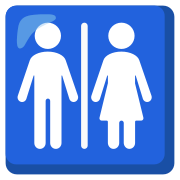🚻
 | ||||||||
| ||||||||
Translingual[edit]


Symbol origin[edit]
The pictogram as well as the simplistic gendered symbols used for public toilets, 🚺 for female and 🚹 for male, were created by British Rail for their train stations in circa 1965,[1] depicting a woman wearing a triangular skirt on the left and a man on the right, separated by a divider—a line.[2]
This became standardised in the United States in 1974 when the Department of Transportation collaborated with the American Institute of Graphic Arts et al. on iconography for the public called the DOT pictograms, which included several versions of 🚻 and the other gender-specific symbols.[3] The depictions of the man and woman were based on the Isotype picture language developed in Austria between 1925 and 1934.[4][5]
Description[edit]
Depiction of a man and a woman standing, sometimes separated by a divider (but see usage notes).
Symbol[edit]
🚻︎
- Marks public toilets.
- 2008, Bernard Darras, Images et sémiologie: sémiotique structurale et herméneutique [Images and semiology: structural semiotics and hermeneutics] (in French), Éditions de la Sorbonne, →ISBN, page 136:
- Il repère rapidement un conglomérat de signalétique dans lequel il sélectionne le double pictogramme de silhouettes humaines accom-pagné d’une flèche.
- He quickly spotted a conglomeration of signage from which he selected the double pictogram of human silhouettes accompanied by an arrow.
- 2022 January 19, Oliver Dunskus, 88 Temples in 55 Days: A Supplement to the 88 Temples of Shikoku (in English), Books on Demand (BoD), →ISBN, pages 7, 15:
- 🚻 Toilets [...] A Tamaga Pass (450 m), 🚻
Usage notes[edit]
- Depictions of the symbol vary, especially the presence of a divider, placement of the people and their look. But generally, the woman is depicted as feminine, often by wearing a skirt, whereas the man is depicted as a generic stick figure wearing long pants.[5][6] At restaurants and other businesses, it is common to see novelty and jocular variations of 🚻, ranging from slight differences to puns often focusing on gender stereotypes or allusions to the masculine and feminine body parts.[7] However, some of these variants may be viewed as unnecessarily confusing or offensive.[8][9]
- The symbol (named "toilets - unisex" and designated PF 003) is part of the ISO 7001 set of pictograms and symbols for "public information" by the International Organization for Standardization.[10]
- As an emoji, almost all operating systems display this symbol as a blue or grey box with the man on the left and woman on the right, both coloured white. Facebook for Android and desktop and OpenMoji depict the woman on the left; in addition, Facebook colours the woman pink and the man blue. iOS, WhatsApp for Android and desktop, and Facebook depict the people as having a single leg. The presence of the divider also varies by system.[11] The Unicode character itself displays the generic icon—man on the left—with the divider.[12] The character was released in Unicode 6.0 in October 2010.[13]
Gallery[edit]
- Depictions
-
ISO 7001
-
DOT pictogram
-
A common emoji depiction (Noto Project pictured)
-
Stylised variant in Budapest, Hungary
-
Common novelty design (pictured in Japan)
Synonyms[edit]
Hyponyms[edit]
See also[edit]
- 🚼 (“marks a baby changing station”)
- 🚿 (“marks a public shower”)
References[edit]
- ^ Association of Public Lighting Engineers (1965) The Illuminating Engineer[1], volume 58, Illuminating Engineering Publishing Company, page 347: “A total lighting load of 20 kw for a toilet may sound excessive but the new luxury toilets recently opened at Victoria Station by British Rail are an exception. […] Large illuminated signs over the entrances incorporate easily recognised continental style pictograms.”
- ^ Jonathan Glancey (2014 September 11) “The genius behind stick figure toilet signs”, in BBC Future[2], BBC News
- ^ American Institute of Graphic Arts (1974 November) Symbol Signs: The Development of Passenger/Pedestrian Oriented Symbols for Use in Transportation-Related Facilities[3], United States Department of Transportation, pages 28–32
- ^ Steven Heller (2014 April 24) “The Utopian Origins of Restroom Symbols”, in The Atlantic[4]
- ↑ 5.0 5.1 Margaret Rhodes (2015 May 22) “Redesigned ladies restroom icon cleverly skirts skirt”, in Wired[5]
- ^ Søren Kjørup (2004) “Pictograms”, in Klaus Robering, Roland Posner, Thomas Albert Sebeok, editor, Semiotik / Semiotics (Handbooks of Linguistics and Communication Science), volume 4, De Gruyter, →ISBN, page 3505: “Read as a picture, it typically shows, in a more or less detailed way, a person dressed in long pants, as opposed to the "picture" on the door to the ladies' room which shows a person wearing a skirt.”
- ^ Melanie Gervasoni (2023 September 10) “50 Funny Bathroom Signs People Found Around The World”, in Bored Panda[6]
- ^ Louis Staples (2023 July 22) “Bananas and peaches? The weird world of novelty toilet signs”, in Financial Times[7]
- ^ Keoni Everington (2021 November 25) “Deviant bathroom signs draw fire from Taiwanese netizens”, in Taiwan News[8]
- ^ International Organization for Standardization (ISO) (2023 February) “Public information symbols”, in ISO 7001:2023: Graphical symbols — Registered public information symbols, 4 edition, ISO
- ^ “🚻 Restroom”, in Emojipedia[9], 2023 October 6 (last accessed), Emoji Designs
- ^ “Version 15.1”, in The Unicode Standard[10], Unicode Consortium, 2023 September 12, retrieved 6 October 2023, Transport and Map Symbols, page 2
- ^ “Version 6.0.0”, in The Unicode Standard[11], Unicode Consortium, 2010 October 11, retrieved 5 October 2023
Further reading[edit]
- Rudolf Modley, William R. Myers (1976) Handbook of Pictorial Symbols: 3,250 examples from international sources, Dover Publications, →ISBN, page 61




